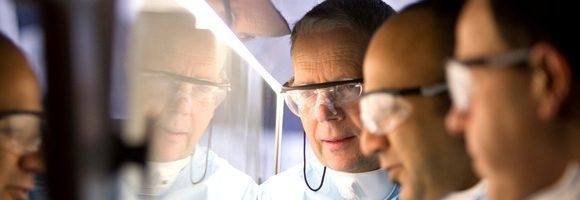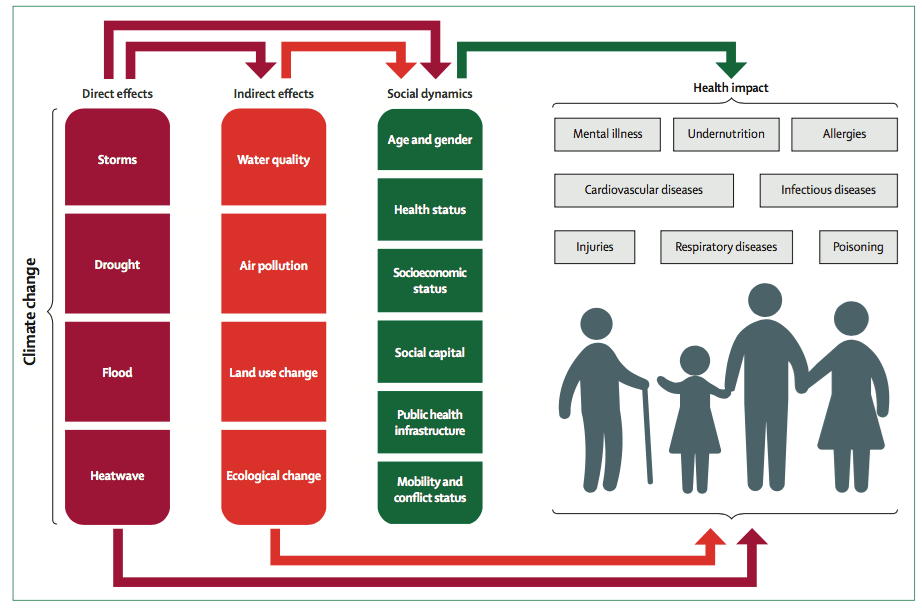In need of a Band-Aid: Johnson and Johnson’s climate change strategy

Johnson and Johnson, the world’s largest healthcare company, needs to update its climate change strategy and focus on the direct impact climate change is having on human health
“Climate change acts as a ‘force multiplier’, exacerbating many of the world’s global health challenges.” 2,3
Climate change and human health: Serious business
In its latest Citizenship and Sustainability report, Johnson and Johnson (J&J) proudly states that as “the world’s largest, broadly based healthcare company,” it is “committed to fulfill [its] unique opportunity to help billions of people live longer, healthier, happier lives today, and for generations to come.”4 An analysis of J&J’s climate change strategy, however, reveals that the organization is doing little to address the direct impact of climate change on human health. J&J has focused exclusively on strategies that mitigate future climate change. It has ignored that some degree of climate change is inevitable, and will have a direct, detrimental impact on health, necessitating adaptation strategies.5 In taking a one-sided approach to climate change, J&J has exposed itself to competitive threats and forfeited a unique opportunity to meet significant current and future medical needs.
Exhibit 1: Climate change can have an indirect and direct effect on health. The former can be addressed with climate change mitigation strategies and tactics, while the latter needs to be addressed by adaptation strategies and tactics. Adapted from2
J&J’s mitigation-focused climate change strategy: High-risk, low return
In 2015, J&J revealed that it failed to meet 30% of the goals outlined in its 2010 “Healthy Future” climate change commitment.1,4 Shaun Mickus (Executive Director of Corporate Citizenship), seemed to dismiss these results, noting “…that’s OK because a lot of these goals were very much stretch goals.”1 This performance, along with J&J’s conspicuous absence from the UN’s database of actions on climate change adaptation, is evidence of an ineffective climate change strategy.6 In contrast, J&J’s competitors have adopted broad and proactive strategies, focused on mitigation and adaptation. Bayer is working to develop treatments for diseases carried by insect vectors thought to increase with rising temperatures.7 Other multinational competitors, including Unilever, Novartis and Pfizer have initiated similar strategies.7,6 Thus far, J&J has responded by setting additional internal waste reduction goals – an insufficient step forward.8
Exhibit 2: President Obama outlines the American Business Act on Climate Change – a necessary but insufficient first step focused on climate change mitigation (but not adaptation).
Adaptation-focused climate change strategies: An opportunity for J&J to demonstrate its commitment to human health, and strength in innovation
The prestigious medical journal The Lancet recently concluded that “climate change could be the greatest health opportunity of the 21st Century.”2 Climate change will lead to a greater prevalence water and vector-borne illnesses, and cardiovascular and respiratory conditions.9 This will increase demand for healthcare services, vaccines and drugs. As a healthcare leader with expertise in drug development, drug delivery technologies, as well as chemical and materials manufacturing, J&J is uniquely positioned to develop a comprehensive plan to address the direct impact of climate change on human health. A climate change initiative that includes adaptation strategies and tactics would help the company address this opportunity, and truly “help billions of people live longer, healthier, happier lives today, and for generations to come.”4
Charting a path forward: Getting J&J’s climate change strategy on track
Stage 1: Adopt a broader climate change policy and partner with early-movers
In the near term, J&J should recognize current thinking in climate change research and adopt a climate change policy that places equal weight on mitigation and adaptation. As a goal, J&J should partner with other healthcare organizations (e.g. universities or non-profits) that have made inroads in developing a comprehensive climate change strategy, including prioritizing relevant unmet medical needs that need to be addressed through current and future innovations.
Stage 2: Prioritize and invest in products that facilitate climate change adaptation
In collaboration with partner(s) developed as part of stage 1, J&J should optimize its R&D pipeline to anticipate and address current and future medical needs triggered by climate change. As a goal, J&J should establish a pipeline of relevant products that anticipate future unmet medical needs, so that they can provide maximal benefit when commercialized.
In hot water: Playing devil’s advocate
Critics of the above argument and proposed action plan may argue corporations have no legal, social or fiduciary responsibility to tackle the impact of climate change on health. As noted above, however, J&J’s competitors disagree. Climate change will ultimately need to be addressed by corporations, governments and non-profit organizations.7 The corporations that are most proactive in addressing climate change are likely to secure economic benefits from relationships developed between such stakeholders. These corporations are also likely to be rewarded by customers, regulators and shareholders. As a healthcare leader and a good corporate citizen, J&J cannot afford to allow its competitors to gain an advantage in addressing one of the most pressing challenges facing humanity.
(Word Count: 799)
Sources
1. Timperley, J. How to reduce a hospital footprint : Johnson & Johnson lays out new 2020 sustainability goals. 29–32 (2016). Available at: http://www.businessgreen.com/bg/interview/2466369/how-to-reduce-a-h…al-footprint-johnson-johnson-lays-out-new-2020-sustainability-goals. (Accessed: 29th October 2016)
2. Watts, N. et al. Health and climate change: Policy responses to protect public health. Lancet 386, 1861–1914 (2015).
3. Climate change impacts on health. Available at: http://www.climateandhealthalliance.org/climate-health/climate-change-impacts-on-health. (Accessed: 2nd November 2016)
4. Johnson and Johnson. People. Places. Practices: 2015 Citizenship & Sustainability Report. (2015).
5. Change, C. & Framing, H. Climate Change and Health: Framing the Issue. Notes
6. Climate Change – Adaptation Private Sector Initiative – database of business cases. Available at: http://unfccc.int/adaptation/workstreams/nairobi_work_programme/items/6547.php.
(Accessed: 2nd November 2016)
7. United Nations Global Compact (UNGC). Business and Climate Change Adaptation: Toward Resilient Companies and Communities. (2012).
8. FACT SHEET : White House Announces Commitments to the American Business Act on Climate Pledge. (2016). Available at: https://www.whitehouse.gov/the-press-office/2015/10/19/fact-sheet-white-house-announces-commitments-american-business-act%0ASHARE. (Accessed: 30th October 2016)
9. Grossman, D. (Green L. G., Erikson, J. (SustainAbility) & Patel, N. (UNEP). GEO-5 for Business: Impacts of a Changing Environment on the Corporate Sector. (2013).




Really interesting post; definitely not a topic I’d heard much about before reading. Thinking through all this, I wonder if, at its heart, J&J is confronting a strategy question, a technology/innovation question, or a leadership question. While you mention that competitors are beginning to look at the climate change from the adaptation side, I think we’re still in the very early stages. Do you think companies like J&J are struggling to identify exactly how they can assist consumers with adaptation strategies or is it just a lack of initiative? Is this not the same as industries across the spectrum, from aviation to construction, to government? At its heart, I think it might boil down to something scarier: perhaps we’re seeing so little innovation in the adaptation category (from J&J and others) because we fundamentally just don’t know how to adapt to our own, man-made climate change?
Really like your strategic suggestions! And I agree with your insight that all parties- but ESPECIALLY corporations- need to take a proactive approach to climate change. The impact that government and NGO’s can have is limited by a variety of means (including ineffective legislatures), but the impact that corporations can have can be much more quickly scaled if that investment in the initiatives is taken.